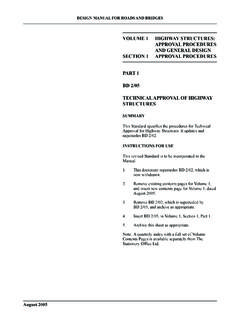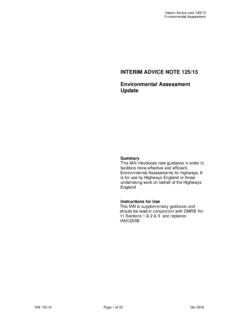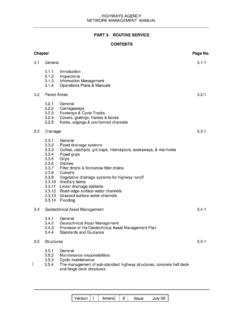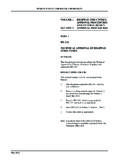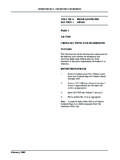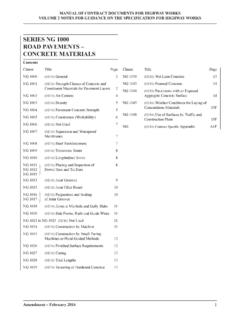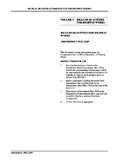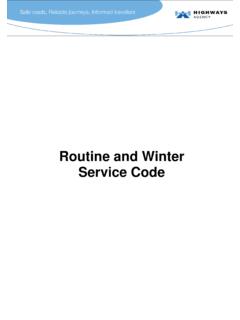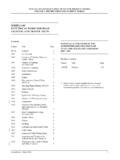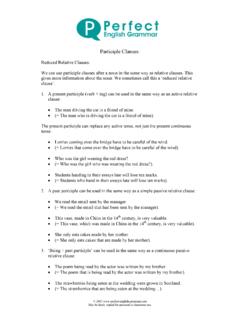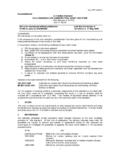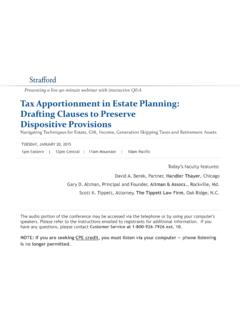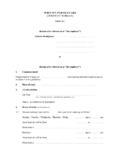Transcription of INTERIM ADVICE NOTE 97/07 (IAN 97/07) …
1 INTERIM ADVICE Note 97/07 assessment and upgrading of existing vehicle parapets IAN 97/07 Page 1 of 49 Aug 07 INTERIM ADVICE NOTE 97/07 (IAN 97/07 ) assessment and upgrading of existing vehicle parapets SUMMARY This INTERIM ADVICE Note: Supersedes BA 37/92, Priority Ranking of existing parapets and IAN 72/06, INTERIM ADVICE on the upgrading of parapets Introduces ALARP based risk ranking tools for existing parapets Supplements and partially supersedes TD 19/06, Requirement for Road Restraint Systems Provides ADVICE on assessment of parapet and safety barrier supporting members on bridges and retaining walls Provides ADVICE on substandard parapet connections and transitions INTERIM ADVICE Note 97/07 assessment and upgrading of existing vehicle parapets IAN 97/07 Page 2 of 49 Aug 07 INTERIM ADVICE NOTE 97/07 assessment AND upgrading OF existing vehicle parapets CONTENTS Section Description Page No. 1. Introduction.
2 3 2. 3. 4. ALARP Based Risk assessment 5. Risk assessment of existing Parapet Sites ..8 6. assessment of Parapet Remnant Containment Capacity .. 11 7. upgrading of existing parapets .. 15 8. Obsolete/Substandard Parapet Connections and 18 9. List of Documents to be Withdrawn/Amended .. 21 10. Contacts .. 22 11. 23 Appendix A: ALARP Based Risk Ranking Tools .. 24 Appendix B: Incursion Risk Ranking Tools .. 28 Appendix C: Identification of Substandard BACO parapets .. 46 Appendix D: assessment of Parapet Supporting 48 INTERIM ADVICE Note 97/07 assessment and upgrading of existing vehicle parapets IAN 97/07 Page 3 of 49 Aug 07 INTERIM ADVICE NOTE 97/07 assessment AND upgrading OF existing vehicle parapets 1. Introduction INTERIM ADVICE Note 72/06, INTERIM ADVICE on the upgrading of existing parapets , now superseded by this INTERIM ADVICE Note, improved previous assessment and upgrading guidance by providing ADVICE in the following areas: The use of DfT17and TRL18incursion risk ranking tools to provide criteria for identifying sites requiring upgrading with very-high containment (H4a) road restraint systems.
3 Amendments to BA 37/92, Priority Ranking of existing parapets , to be consistent with the IRRRS, INTERIM Requirements for Road Restraint Systems (now superseded by TD 19/06), and the incursion risk ranking tools, to enable a consistent risk assessment approach. This INTERIM ADVICE Note (IAN) revises the previous ADVICE to be consistent with the risk-theory based approach of TD 19/06, Requirement for Road Restraint Systems , whilst enabling significant cost and programme related benefits, and reduced congestion. Additional and expanded ADVICE is provided in the following areas: Guidance which supplements and partially supersedes TD 19/06. The incursion risk ranking tools are brought together in a single Appendix, which also includes ADVICE for the single carriageway road over road risks, not previously covered by IAN 72/06. The introduction of ALARP based risk ranking tools, which supersede the BA 37/92 priority ranking framework.
4 assessment of parapet supporting members and safety barrier supporting members on bridges and retaining walls. assessment of obsolete/substandard parapet connections and transitions. Identification and assessment of substandard BACO parapets . A consistent risk based approach, using incursion and ALARP based risk ranking tools, and the TD 19/06 Road Restraint Risk assessment Process (RRRAP), to enable realistic risk levels to be ascertained together with associated upgrading ADVICE . This IAN does not cover risks associated with bridges/structures over or adjacent to high risk facilities ( schools, chemical plants) or risks associated with on-deck vehicle collision with main structural members of bridges ( , half-through girders). The Highway Agency s vehicle Restraints and Risk Management Team should be consulted for ADVICE on assessing these types of risks. INTERIM ADVICE Note 97/07 assessment and upgrading of existing vehicle parapets IAN 97/07 Page 4 of 49 Aug 07 2.
5 Scope This IAN should be used for all proposals to assess or upgrade existing parapets or parapet connections, on Agency-owned structures. It is similarly applicable where carriageway widening or realignment proposals increase the likelihood of vehicle collision with existing parapets . This document should be read in conjunction with TD 19/06, which is supplemented and partially supplemented by this ADVICE . This IAN is also applicable for maintenance works or carriageway widening/realignment works carried out during Targeted Programme of Improvement (TPI) projects. INTERIM ADVICE Note 97/07 assessment and upgrading of existing vehicle parapets IAN 97/07 Page 5 of 49 Aug 07 3. Implementation This IAN should be used on all schemes, except for those already under construction or those currently being prepared where there would be significant additional cost or delay caused by its use. Refer to TD 19/06 clauses to for the terminology, definitions and abbreviations relevant to this IAN.
6 INTERIM ADVICE Note 97/07 assessment and upgrading of existing vehicle parapets IAN 97/07 Page 6 of 49 Aug 07 4. ALARP Based Risk assessment Framework The risk assessment approach adopted in this IAN is consistent with the risk-theory based approach adopted in TD 19/06. TD 19/06 and this IAN adopt the ALARP principle in assessing tolerability of risk levels. ALARP (As Low as Reasonably Practicable) originated in the nuclear industry as a method for ranking and prioritising responses to risks. The Health and Safety at Work etc Act 1974 recognises the ALARP principle in addressing risk. There is a level of risk considered intolerable to individuals and society, and similarly a level of risk considered broadly acceptable . If the risk falls in the tolerable region between these two levels, then the Act requires that the risk be reduced to a level which is as low as reasonably practicable provided that the cost or effort required to reduce the risk is not grossly disproportionate to the benefits (the ALARP principle).
7 The principle is illustrated diagrammatically in Fig. of TD 19/06, reproduced here as Fig. Figure The ALARP Principle existing parapets assessed to be within the broadly-acceptable region , or those which satisfy the ALARP principle, are considered acceptable and do not require upgrading . Where parapets are upgraded, the risk should either be reduced to broadly-acceptable , or satisfy the ALARP principle. In both these cases, departures from standards are not required. (Partially supersedes clauses and of TD 19/06) Use of the ALARP based risk ranking tools (given in Appendix A) and incursion risk ranking tools (given in Appendix B) ensure that the risks associated with existing parapet sites are managed in accordance with the ALARP principle, utilising the RRRAP only where the risks associated with existing parapets cannot be demonstrated to be as low as reasonably practicable . This approach also enables relative risk levels to be established, together with suitable mitigation measures, as shown in Table (Partially supersedes clauses and of TD 19/06) Where use of the RRRAP identifies the need for a higher level of containment than N2 on an existing structure, it is essential for the cost-related default values to be overwritten, to reflect the fact that the additional costs associated with providing a higher level of containment are usually far more than they would be for a new structure.
8 Moreover, where the RRRAP identifies the need for Very High Containment Level (H4a) on an existing site, this must only be provided after consultation with the responsible authorities and subject to INTERIM ADVICE Note 97/07 assessment and upgrading of existing vehicle parapets IAN 97/07 Page 7 of 49 Aug 07 prior approval of the Technical Approval Authority. (Partially supersedes clauses and of TD 19/06) Table Risk Levels, ALARP and Risk Mitigation Risk Level Relative Risk (ALARP) Risk Mitigation High ALARP requires H4a upgrade Upgrade to H4a Medium1 ALARP requires H1/H2 upgrade Upgrade to H1/H2 Low1 ALARP requires N1/N22upgrade Upgrade to N1/N22 Very Low existing parapet is ALARP Monitor Risk3 Negligible existing risk is broadly acceptable Do Nothing Notes: 1. existing parapets with remnant capacities less than the required pedestrian level of containment should be considered as high risk, requiring upgrading to appropriate containment levels determined by ALARP.
9 1. N1 or N2 dependent on TD 19/06 minimum design containment requirements. 2. No mitigation is required but the risk should be monitored against ALARP. Where schemes are notifiable under the CDM regulations, the results of ALARP based risk assessments carried out in the design of parapet upgrading works should be included as part of the Health and Safety documentation required under the CDM Regulations. For tendered schemes this will be prior to invitation to tender; for Early Contractor Involvement (ECI) schemes and Design and Build (D&B) or Design Build Finance Operate (DBFO) schemes, prior to commencement of construction; and for term maintenance and framework contracts, prior to issue of the works order or task order to the Contractor. (Partially supersedes clauses and of TD 19/06) INTERIM ADVICE Note 97/07 assessment and upgrading of existing vehicle parapets IAN 97/07 Page 8 of 49 Aug 07 5. Risk assessment of existing Parapet Sites The ALARP based risk assessment process is illustrated by the flowcharts in figures and for bridges over roads and bridges over railways respectively.
10 Note that the road-over-road incursion tools do not apply when the two-way AADT on the upper or lower road is less than 25000. The flowcharts should also be used for retaining walls supporting roads. However, the incursion risk ranking tools only apply when it is considered possible for a parapet penetrating vehicle (or associated debris) to foul the lower route (railway or road). In these exceptional circumstances, the incursion risk ranking tools for bridges given in Appendix B should be used. The flowcharts should also be used for bridges over, and retaining walls adjacent to, rivers, canals and NMU/agricultural access routes. However, the incursion risk ranking tools do not apply. Where it is considered that that there is a very high risk to pedestrians, the HA s vehicle Restraints and Risk Management Team should be consulted for ADVICE in assessing this type of risk. To use the risk process flowcharts, the following parameters need to be defined: RALARP ALARP based risk ranking score.
